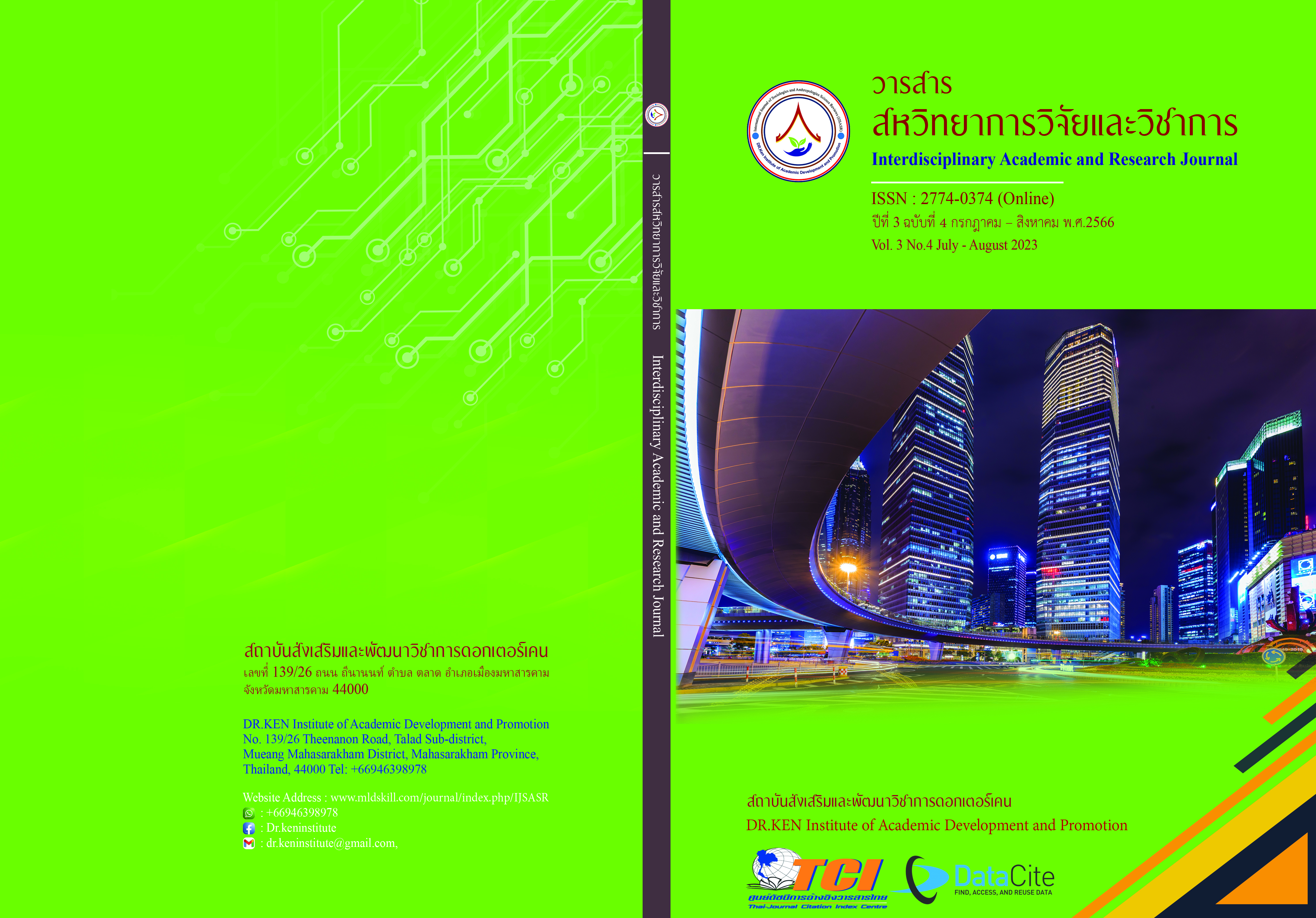Sangha Affairs Administration under the Eastern Maha Nikaya, Sangha Administrative Region 9
DOI:
https://doi.org/10.14456/iarj.2023.188Keywords:
Sangha Affairs Administration; , Maha Nikaya; , Sangha Administrative Region 9Abstract
Buddhism has been the religion of the Thai nation since ancient times, all arts and cultures, traditions, ethics, and virtues that are uniquely Thai, have very important roots in Buddhism. Buddhism is regarded as an invaluable heritage of Thailand. It is a spiritual anchor that causes unity and national security, able to maintain Thainess well all along. The administration of the Sangha in Thailand in the modern era has the Patriarch as the highest authority. The administration of the Sangha in this era is by the Sangha Act B.E. This article aims to analyze the administrative situation of the Eastern Maha Nikaya in the ninth Eastern Maha Nikaya administrative region. The research was divided into three phases as follows; (1) The study of documents aims to bring the results from the study of the Sangha Administration documents as a context for constructing a questionnaire to study the current and desirable conditions in the Sangha administration. (2) An interview with the experts is the use of research results in Step 1 to design a research issue to study the administrative conditions of the clergy. The target group of data is 7 experts. And (3) Analysis of current and desirable conditions. The sample group is 261 monks in Administrative Region 9. Data were analyzed by descriptive statistics, while qualitative data was analyzed by Analytic Inductive. The results showed that; The current state of the Sangha administration as a whole was at the highest level, and the desirable state of the Sangha's administration as a whole was at the highest level. In descending order of the present state, the highest level is the highest; religious education, followed by government, welfare education, mission, public utilities, and public welfare respectively. And the most desirable state in all aspects, in descending order is; Educational welfare, followed by government, religious education, public utilities, missions, and public welfare, respectively.
References
บุญชม ศรีสะอาด. (2556). การวิจัยเบื้องต้น. พิมพ์ครั้งที่9. กรุงเทพฯ : สุวีริยาสาส์น
ประกิต บุญมี และคณะ. (2559). การบริหารกิจการคณะสงฆ์: ศึกษากรณีเขตการปกครองคณะสงฆ์ตำบลท่าไม้ จังหวัดสมุทรสาคร. คณะนิติศาสตร์ มหาวิทยาลัยราชพฤกษ์.
พระครูนิมิตสาธุวัฒน์ (บุญเมือง ชวโน), สมเดช นามเกตุ และ บุญส่ง สินธุ์นอก. (2564). A Guideline of Administration of Sangha’s Duties with Sangahavatthu Principle of Eccl. Administrative Officers in the Administrative Area of NongSaeng District, Udonthani Province. Journal of Modern Learning Development. 6 (3), 44-57.
พระครูใบฎีกาอภิชาติ ธมฺมสุทฺโธ (พรสุทธิชัยพงศ์). (2558). ระบบการบริหารกิจการคณะสงฆ์ไทยในทศวรรษหน้า. วารสารครุศาสตร์ปริทรรศน์ฯ. 2 (2), 126-139.
พระครูปลัดกิตติวัฒน์ (คชา ปญฺาธโร). (2554). การบริหารจัดการวัดของพระสังฆาธิการในอำเภอบางเลน จังหวัดนครปฐม. วิทยานิพนธ์พุทธศาสตรมหาบัณฑิต (พระพุทธศาสนา) : มหาวิทยาลัยมหาจุฬาลงกรณราชวิทยาลัย.
พระครูพินิตสุตาคม (สมพงษ์ สุตาคโม). (2554). การบริหารจัดการของเจ้าอาวาสวัดในเขตการปกครอง คณะสงฆ์อำเภอกำแพงแสน จังหวัดนครปฐม. วิทยานิพนธ์พุทธศาสตรมหาบัณฑิตสาขาวิชาการจัดการเชิงพุทธ: มหาวิทยาลัยมหาจุฬาลงกรณราชวิทยาลัย.
พระครูเมตตามงคลวิศิษฏ์ (วัชรินทร์ อคฺควโร). (2559). การบริหารงานกิจการคณะสงฆ์ของพระสังฆาธิการในเขตกรงเทพมหานคร. Journal of Yanasangvorn Research Institute. 8 (2), 59-69.
พระครูรัตนญาณวิมล (มนตรี รตนญาโณ). (2556). การบริหารกิจการคณะสงฆ์ในเขตอำเภอกระสังจังหวัดบุรีรัมย์. วิทยานิพนธ์พุทธศาสตรมหาบัณฑิต (พระพุทธศาสนา): มหาวิทยาลัยมหาจุฬาลงกรณ์ราชวิทยาลัย.
พระครูสังฆรักษ์สมศาสตร์ โฆษิตธมฺโม. (2552). การมีส่วนร่วมของพระสงฆ์ระดับเจ้าคณะอำเภอรองเจ้าคณะอำเภอ เลขานุการเจ้าคณะอำเภอ เลขานุการรองเจ้าคณะอำเภอในการบริหารงานคณะสงฆ์จังหวัดเชียงราย. วิทยานิพนธ์มหาบัณฑิต: มหาวิทยาลัยราชภัฏเชียงราย.
พระเทพเวที ประยุทธ์ ปยฺตโต. (2534). การพัฒนาจริยธรรม. กรุงเทพฯ : ภาควิชาปรัชญาและศาสนา วิทยาลัยครูสวนดุสิต.
พระมหานพดล นวคุโณ (ถ่อนสันเทียะ) และคณะ. (2560). รูปแบบการบริหารกิจการคณะสงฆ์สู่ความเป็นเลิศของพระสังฆาธิการระดับเจ้าอาวาส. วารสารบัณฑิตศึกษาปริทรรศน์. 13 (3), 335-346.
พระเมธีธรรมาลังการ (ประยุทธ ภูริธตฺโต). (2551). ประสิทธิภาพการบริหารงานคณะสงฆ์จังหวัดแพร่. มหาวิทยาลัยมหาจุฬาลงกรณราชวิทยาลัย วิทยาเขตแพร่.
พระอนุชา ธมฺมวโร (วงษ์ประพันธ์). (2556). ประสิทธิภาพการบริหารกิจการคณะสงฆ์ของวัดในอำเภอเมือง จังหวัดขอนแก่น. กรุงเทพฯ: มหาวิทยาลัยมหาจุฬาลงกรณราชวิทยาลัย.
พีระศิลป์ บุญทอง . (2561). การบริหารกิจการคณะสงฆ์ของคณะสงฆ์ในภาคใต้. วารสารมหาจุฬานาครทรรศน์. 5 (1), 30-44.
พีรัชชัย วีระสุนทร. (2551). กฎหมายว่าด้วยการปกครองคณะสงฆ์ไทย. กรุงเทพฯ : มหาวิทยาลัยอัชสัมชัญ.
ไพศาล วรคำ. (2555). การวิจัยทางการศึกษา. พิมพ์ครั้งที่ 5. มหาสารคาม: ตักสิลาการพิมพ์.
สำนักงานพระพุทธศาสนาแห่งชาติ. (2565). การปกครองคณะสงฆ์ไทย. Retrieved from: https://www.onab.go.th/th/content/category/detail/id/57/iid/2474
สำนักงานสถิติแห่งชาติ. (2555). รายงานสถิติรายปีประเทศไทย พ.ศ.2555. กรุงเทพฯ: สำนักงานสถิติแห่งชาติ.
Krejcie, R. V., & Morgan, D. W. (1970). Determining sample size for research activities. Educational and Psychological Measurement, 30(3), 607–610.
Downloads
Published
How to Cite
Issue
Section
License
Copyright (c) 2023 Phraatchaya Chantasupho, Chumnian Pollaharn, Kritkanok Duangchatom

This work is licensed under a Creative Commons Attribution-NonCommercial-NoDerivatives 4.0 International License.
Copyright on any article in the Interdisciplinary Academic and Research Journal is retained by the author(s) under the under the Creative Commons Attribution-NonCommercial-NoDerivatives 4.0 International License. Permission to use text, content, images, etc. of publication. Any user to read, download, copy, distribute, print, search, or link to the full texts of articles, crawl them for indexing, pass them as data to software, or use them for any other lawful purpose. But do not use it for commercial use or with the intent to benefit any business.
















.png)


